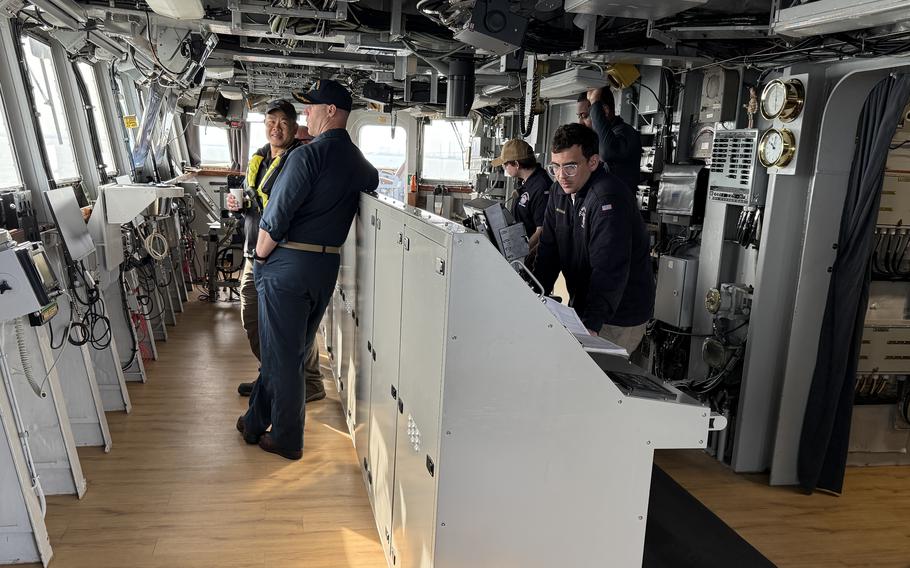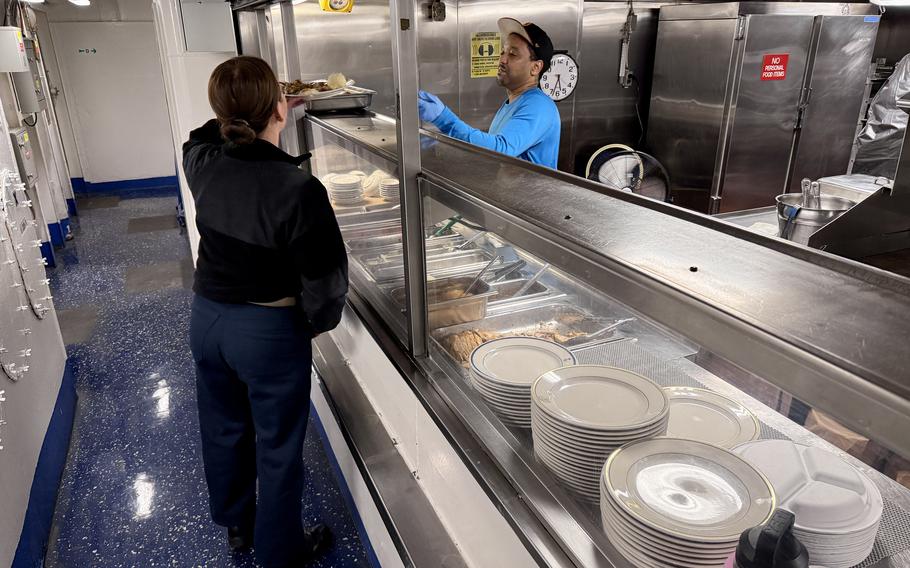Civilian mariners on USS Mount Whitney crew are flagship's fail-safe, Navy sailors say | Stars and Stripes

Crew members from USS Mount Whitney, the U.S. 6th Fleet flagship, are shown May 13, 2025. The ship's crew of about 300 consists of Navy sailors and civil service mariners. Military personnel serving aboard Mount Whitney say the hybrid arrangement affords them better opportunities for gaining proficiency in their jobs. (Alison Bath/Stars and Stripes)
NAPLES, Italy — Cook and baker Geremie Topacio is normally at work by 5:30 a.m., preparing breakfast for a crew of about 300 aboard the 6th Fleet flagship USS Mount Whitney.
She is one of about 125 Military Sealift Command civil service mariners on the ship assigned a range of tasks from kitchen duty to cleaning, maintenance, engineering, even navigation.
That wide-ranging responsibility and expertise is why the steam-powered, command-and-control ship in service for more than five decades “never fails to sail,” said crew members aboard the ship.
Topacio takes note of individual food preferences, such as how her shipmates like their eggs, because she believes that making people feel special helps take the sting out of being away from home.
“I love seeing people’s face light up when they get their plate because it’s the food that they want,” said Topacio, who has served aboard Mount Whitney for more than a year.
Experts cite Military Sealift Command’s efficient support as one reason the hybrid crewing model should be considered for other surface combatants, such as amphibious assault ships.

Navy sailors and civil service mariners, or CIVMARS, man the bridge of USS Mount Whitney as it comes into port at Naval Station Rota, Spain, on May 13, 2025. Mount Whitney is one of about seven ships in the service with hybrid crews under the leadership of a Navy captain. (Alison Bath/Stars and Stripes)
Such a move could save hundreds of millions of dollars a year and allow the Navy to keep ships adequately crewed while on station longer, making it easier to grow the fleet, according to a December 2020 U.S. Naval Institute report.
The sealift command keeps Mount Whitney operational, providing the platform and mobility needed as the Navy projects power in Europe and Africa, said Capt. T.J. Pekin, chief mate, or Military Sealift Command officer in charge.
That relationship likely is the highest form of military/civilian integration “because one doesn’t operate without the other on this platform,” Pekin said.
Mount Whitney is one of about seven Navy ships, including the expeditionary sea bases USS Hershel “Woody” Williams and USS Lewis B. Puller, with hybrid crews of sailors and civil service mariners, or CIVMARs, under the leadership of a Navy captain, according to the command.
Its operations support Navy ships, pre-position combat cargo and conduct special missions, among other tasks.
But the command is facing a severe shortage of the CIVMARs needed to crew the 140 government and commercially owned or chartered vessels it manages. They include replenishment oilers, salvage ships and hospital ships.
There are about 6,093 civil service mariners working for the command, according to the MSC 2025 handbook. But more are needed to ensure adequate staffing, the command said earlier this year without specifying the number of new hires required.
To address the labor crunch, the Navy has sidelined 14 support ships with the idea of rotating crews from those vessels to higher-priority ships to minimize the number of personnel who are overdue for leave and training.
The strategy also would offer a more predictable work schedule for civil service mariners, the command said in February.

A civil service mariner brushes butter on freshly baked rolls aboard USS Mount Whitney on May 7, 2025. About 125 civilian mariners aboard the ship are assigned tasks ranging from food service to cleaning, maintenance, engineering and navigation. (Alison Bath/Stars and Stripes)
Williams and Puller, assigned to Africa and the Middle East, respectively, are ships that could see their operations pared down.
On Mount Whitney, civil service mariners’ ability to handle most shipboard operations offers sailors better opportunities to advance their careers compared to those assigned to other Navy vessels, military personnel serving on the ship say.
For example, three CIVMARs usually man Mount Whitney’s bridge, a task that typically would take as many as eight Navy sailors on watch, said Lt. Cmdr. Kenyon Cowart, a combat systems maintenance officer on the ship.
Because vessels managed by MSC are operated by civilians, crew level and organization are more closely aligned with that of civilian commercial ships rather than warships, according to the command.
“It’s impressive what they are able to do,” Cowart said. “The amount of work they’re able to do with less manning is awesome.”
As a result, sailors serving aboard the vessel typically don’t work in the kitchen, fill in as damage control petty officer for another division or get other temporary added duty assignments, they said.
Those assignments, which can last weeks, are frustrating for junior sailors who are eager to gain proficiency in their jobs, said Ensign Joshua Coatney, an electronics material officer.
MSC crew members allow sailors to remain “focused on their job and really get good at their at their rate, which is just a huge blessing,” Coatney said.
The lack of extra duties also allows more time to complete education requirements and get proper rest, he and other sailors pointed out.
Mount Whitney also benefits from the knowledge and sea experience of CIVMARs, some of whom have long served on the ship and know its unique features and requirements, said Capt. Colin Price, Mount Whitney’s commanding officer.
“That is one of the things that gives me great comfort on being the captain of the ship,” Price said.
While many sailors may be familiar with MSC, few live and work alongside their civilian counterparts like the hybrid crew on Mount Whitney. That arrangement fosters unity and greater understanding of CIVMAR contributions, according to Price.
“I’ve seen too right here that there are other ways to serve our country than just joining the military,” he said.

A Navy sailor aboard USS Mount Whitney is served a meal by a civil service mariner on May 12, 2025. Mount Whitney is one of about seven Navy ships managed by Military Sealift Command with a hybrid crew of military personnel and civilians. (Alison Bath/Stars and Stripes)










